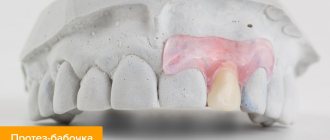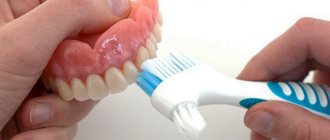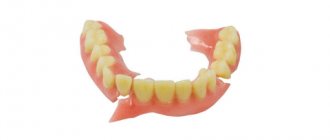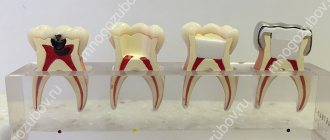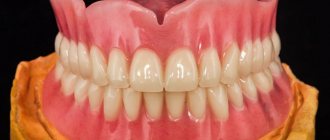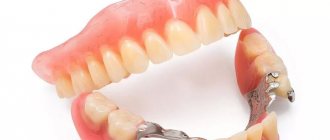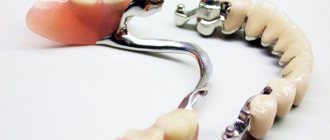Removable dental bridges and dentures are in great demand due to their affordable cost. Removable dentures are used for complete or partial loss of teeth, as well as as a temporary solution until a fixed structure is installed.
It should be noted that modern prosthetics are very different from the bulky and uncomfortable products of the last century. Now they look more aesthetically pleasing, have a natural appearance, fit tightly to the gums and are securely fixed.
Indications for removable prosthetics can also be inflammation of the gums, bone deficiency, or contraindications to the installation of dental implants.
Installation Features
Removable structures have a base that imitates natural gums. Therefore, they look natural, like natural teeth.
In case of complete edentia, the removable denture is attached directly to the gums. The prosthesis fits tightly to the soft tissues, without displacement or loosening.
The prosthesis is fixed using clasps, hooks or implants. The lower part is attached to the roots of the natural teeth, and the upper part is attached inside the base of the structure. If the prosthesis replaces the entire dentition, then fixation occurs only on the gums.
Types of removable dentures
Dentures for complete absence of teeth
These removable dentures are a lightweight, curved plastic plate that covers the entire jaw and palate (if used on the upper jaw). Artificial teeth (made of plastic or porcelain) are attached to it. The removable bridge is fixed due to the natural suction effect of the gums. The use of removable structures is possible only in the case of complete edentia (loss of all teeth).
Conditionally removable orthopedic prostheses
Such removable dentures can be used in case of loss of single teeth (for example, chewing teeth) or in case of significant violations of the integrity of the dentition (loss of a group of teeth). These orthopedic elements can also act as temporary structures. To fix them on natural teeth, special locks (clasps) are used. The component is made of durable metal, which ensures its reliable installation.
It is important to understand that not all partial denture materials are suitable for restoring teeth in the smile area. Therefore, in the case of restoration of the front teeth, it is better to choose removable dentures on implants.
Lamellar
This type of plate dentures is most often used in cases of loss of chewing teeth. This is one of the simplest and most affordable removable dentures.
Removable sectors or segments.
They are unilateral partially removable dentures used when several chewing teeth are lost in a row on one side of the jaw.
Immediate dentures
This is a temporary structure. This product is designed to hold adjacent teeth in place and protect gums until a permanent denture or crown is fabricated. Externally, an immediate denture looks like an ordinary tooth, but on the sides it has special clippers in the form of wings, with the help of which it is secured to the gum. Thanks to these fastenings, it received its second name - “butterfly”
Complete dentures: should they be removed or not?
There is no strict requirement to remove a full-type removable orthopedic system at night. It may well remain in the mouth during sleep. But in some situations it is better to remove it to prevent:
- neurosis, in the presence of fear that you might choke on a displaced prosthesis in your sleep or swallow it;
- overheating of the gums, which have been under plastic that does not conduct heat well for a long time, and its contamination with pathogenic microorganisms;
- continuous pressure on the mucous membranes, which worsens their condition.
Considering the above, many dentists do not recommend wearing complete removable dentures around the clock, especially if hygiene procedures are performed poorly and irregularly.
Modern materials
Removable acrylic dentures
Budget option based on polymers. Conventional plastic dentures strongly rub the gums and do not fit well. However, our laboratory specialists use a special formula - a new generation acrylic prosthesis, with the addition of crushed diamond chips. The design is more resistant to chewing loads, comfortable to wear and has an aesthetic appearance, and also provides a longer service life.
Elastic
These can be soft nylon or thin removable dentures made of acrylic resins (Acry Free). The material adheres tightly to the gum tissue in the oral cavity. Does not cause pain or discomfort. Can be used for bruxism.
Who is suitable for nylon prostheses?
The use of removable nylon dentures is acceptable in the absence of one or several teeth. The products are used in cases of lack of extreme, lateral or front teeth in a row and even in cases of complete edentia. Edentia is commonly understood as the absence of all teeth in a row or jaw. The use of removable dentures made of nylon is possible for sensitive and weak gums, as well as for restoring dentition in children. Such orthopedic products do not contain metal compounds and are excellent for patients with allergic reactions. As for nylon itself, it is absolutely hypoallergenic.
With locks (sandwich dentures)
Installation requires two healthy tooth roots. One part of the lock is attached to the dental bridge, the second (abutment) is fixed in the root of the tooth. The prosthesis does not have a septum in the palate, which ensures maximum taste sensitivity. Thanks to the partial overlap, the removable denture can be worn for several days, only being removed for cleaning.
Dentures on implants
The most popular type of prosthesis. It is securely attached to the gum due to four supports connected to each other by a beam. Removable dentures on implants provide an even load on the jawbone, and the absence of a palate in the structure guarantees a natural taste perception when eating. It is easy to use, has a long service life and can be easily replaced with a new one if necessary. The only drawback is the high cost of installation due to the materials used. However, the price is fully justified by the quality, comfort and durability of the product.
Clasp dentures
This type of prosthesis is suitable for complete and partial restorations. Due to its aesthetics and affordable price, removable clasp dentures are in high demand among patients in dental clinics.
When making a removable clasp denture, specialists use a base made of elastic plastic, to which a metal beam is attached. Dental crowns made of artificial materials are fixed on the latter. Depending on the type of structure and the wishes of the patient, crowns on a dental bridge can be made of plastic, metal or metal-ceramics.
A partially removable denture is attached using clasp hooks if there are native supporting teeth. Or it could be a hidden mechanism that connects the crown to the base of the tooth. The clasp bridge is easy to use - it does not need to be removed before going to bed.
Method No. 2: on the patient’s natural teeth
A modern overdenture can be more securely fixed in the mouth if there are supporting teeth or preserved roots. This fastening option is possible to improve the fixation of removable appliances even if there are extensive defects1 in the dentition, and when only a few elements have been preserved that can become supporting ones. There are several mounting options available here.
A tooth-retained overdenture is also removable, but it is lighter and more compact than a design that is retained solely on the gums. It has a reduced palatal overlap, and sometimes there is no such overlap at all (for example, in sandwich dentures), which allows the patient to feel the taste of the food consumed. However, such devices contribute to rapid wear and destruction of the supporting elements of the row, because during operation they bear a serious load.
On clasps
Such overdentures are attached to the mouth using special hooks that tightly grip the supporting elements of the row. This is one of the most financially accessible, but not always convenient and aesthetic varieties. After all, hooks can be noticeable in the smile area. In addition, clasps can become loose and fail, which ultimately leads to instability of the entire system, displacement of the devices, and physical and psychological discomfort.
The photo shows a prosthesis with clasps
“I had to remove a couple of teeth. After that, for several weeks I agonized over the best way to restore them - with bridges or implants. I can’t decide on either one or the other... And money is still tight. And so my doctor advised me to temporarily install the covering apparatus on hooks, saying that it was inexpensive and there was no need to sharpen my teeth for it. I agreed on the condition that while I was wearing it, I would calmly make a choice and save money for a normal treatment option.”
LenaElena, review from 32top.ru
On attachments or clasps
One part of the fastening is installed in the abutment tooth or root, and the second is installed in the base of the removable product - the two elements are simply combined and snapped into place. This method of fixation significantly increases the stability of the structure and also improves its performance characteristics. The overdenture with clasps is compact and lightweight. The patient no longer has to take it out of his mouth every day. However, the price for it is much higher than for a product with hooks.
This is what a prosthesis with clasps looks like
Teeth cannot be used as support if they are severely damaged or inflamed, have cysts and granulomas on the roots, or are loose due to periodontitis and periodontal disease. They must first be cured, if, of course, they are treatable. In the latter case, that is, with periodontal diseases, the doctor can offer the patient a special splinting structure (clasp devices) with hooks that tightly grasp each loose element of the row.
Using telescopic crowns
When doctors offer patients overdentures attached to telescopic crowns, not everyone understands what it is. The design of such devices provides for the presence of several hollow crowns that are fixed to the supporting elements of a row, previously covered, again, with artificial crowns.
The photo shows a prosthesis on telescopic crowns
The connection of all components of the system into a single whole occurs according to the telescopic principle, when one crown is made slightly smaller in diameter than the other. As a result, the two fastening elements fit tightly onto each other, which ensures high quality fixation. The price of such products is quite high, because their production involves painstaking work and a high level of professionalism of the doctors who perform it.
Fastening methods
For complete restoration of the dentition, a spherical or beam method of fastening is used. The first method is used only for fixing 1-2 implants, due to the mobility of the fasteners. A removable denture on a bar provides a strong and reliable fastening of the structure in the mouth. Does not move when talking or eating. Due to the high precision of installation, the patient’s natural bite is restored.
There is a third, screw method: A removable denture is attached directly to implants installed in the bone tissue. Advantages of the method: maximum accuracy of installation, uniform distribution of load on the jaw, high aesthetics.
Telescopic crowns
They are more expensive compared to others. The supporting teeth are ground down and a much smaller crown is placed on them. The entire structure is installed on them, which holds tightly thanks to perfectly fitted shapes.
The points described above describe how removable dentures are attached to the presence of supporting living teeth. But how is a denture attached if there are no teeth?
Fitting and installation
The installation process will take only 2-3 days, and will require 3 visits to the doctor.
The initial stage includes a primary diagnosis of the oral cavity, the condition of the teeth and gums, as well as taking an impression. The production of a removable denture will take from 3 to 14 days, depending on the type of design chosen.
At the stage of installing a removable denture, it is important to assess the level of comfort when wearing it. It is important that the patient does not experience pain during fitting and does not rub the gums.
At the final stage, the doctor secures the prosthesis with clasps and tells the patient how to use and care for it.
In the case of implants with bar fasteners, support rods are first fixed in the jaw tissue. A short break will be required for implantation. After this, a completely removable denture is installed.
If the patient does not have the opportunity to undergo a rehabilitation period, an alternative may be implantation technology with immediate loading. In this case, tooth restoration takes 1-2 days.
With proper use, a removable denture will last you 7-10 years. If damage occurs, it can be repaired, but if the base is damaged or the dental crowns are severely deformed, then our experts recommend replacing the denture with a new one to eliminate the risk of injury to the oral cavity and infection.
Technicians' work
This manufacturing stage largely replicates the steps of the clinical process, since they are closely interrelated.
How dentures are made by technicians:
- Making a cast from plaster.
- Making an individual impression tray based on a plaster cast.
- Production of diagnostic and working models.
- Creating a duplicate of the working model.
- Plastering of the working and auxiliary models in the articulation.
- Placement of crowns on a wax base and filling with plastic.
- Replacing the wax with a polymer base.
- Assembly, polishing and grinding of the finished product.
- Sending the finished product to the orthodontist.
Advantages of removable dentures
Installing a denture helps restore the aesthetics of the dentition. However, this is not its main function. Missing teeth leads to a number of problems: poor digestion, displacement of existing teeth, asymmetry of the facial muscles and difficulties with diction.
Removable prosthetics is an affordable method that helps solve the problem of complete or partial edentia.
Modern dentures are hypoallergenic and safe. High-quality materials allow us to develop durable structures with strong fixation in the oral cavity.
Pros and cons of nylon prostheses
Medical nylon dentures are lightweight and comfortable designs that are used both for complete and partial loss of teeth. They are strong, relatively durable, aesthetically pleasing - almost invisible to others, and make it possible to completely restore chewing function. Such prosthetics can be used if the budget is limited or implantation is not possible for medical reasons.
But it has a number of disadvantages:
- not a particularly reliable fastening, even the highest quality system “looses” over time;
- requires regular hygiene - cleaning;
- systems are significant in size;
- The term of use of a removable denture is up to 5 years.
Care
Cleaning a removable denture is not much different from cleaning natural teeth. Although it has its own characteristics.
After each meal, it is recommended to rinse them thoroughly with water. This will prevent bacteria and infection from entering the gums.
It is better to clean it with professional products suitable for its material. If the structure is completely removable, it is recommended to leave it in a disinfectant solution before going to bed.
Periodically check the denture for cracks and chips. If any damage is found, consult a doctor immediately.
For preventive purposes, it is important to visit the dentist at least once every six months. The specialist will conduct a professional examination, check the condition of the jaw and gum tissue, and also clean the dental bridge from contamination.
Care and storage of nylon prostheses
The products can be worn around the clock. They only need to be removed for hygiene purposes - cleaning. After eating, you should rinse with plain running water every time. At least 2 times a day, preferably at the beginning and end of the day, you should thoroughly clean off food debris using a special brush. Experts do not recommend using aggressive means.
They can be cleaned using regular soap and a brush. The service life of the medical system will be extended by using special baths and pastes for these purposes several times a week, and using antiseptic liquids purchased for these purposes at the pharmacy. Periodically, once every 2-3 months, it is advisable to bring nylon dentures to the clinic for more thorough cleaning.
However, despite the exhaustive information, only an experienced dentist can answer the question of which dental prosthetic option is best for you. A professional will competently assess the condition of the oral cavity, will certainly listen to your wishes and offer the best prosthetic option suitable for you.
Back
Alternative solutions
Atrophy of the jaw tissue becomes a serious argument in favor of fixed prosthetics. In the case of complete adentia due to bone deficiency, the optimal solution is immediate implantation, with fixation of the prosthesis for 2-3 days.
This technology includes All-on-4 and All-on-6 punctures. For installation, 4 and 6 dental implants are used, depending on the condition of the bone tissue. This technology allows you to fix a removable denture immediately after installing the implants.
Titanium rods are almost completely fused with the jaw bone. The prosthesis is tightly fixed to the implants, without the risk of displacement, and it can be loaded immediately after its installation.
The operation includes several stages:
- Initial examination, hardware diagnostics using 3D modeling technology.
- Preparing the jaw for implantation - removing decayed teeth, choosing a site for installing implants.
- Fixation of titanium rods in a gentle manner, with minimal surgical intervention (without deep incisions).
EspaDent's own dental laboratory allows us to produce a removable dental prosthesis in the shortest possible time, without loss of quality or extra costs.
Stock
-9%
BASAL COMPLEX - Restoration of teeth on 1 jaw in 3 days 330,000 rub.
300,000 rub.
get -17 %
Quadrotti dentures (without palate) 60,000 rub.
50,000 rub.
get -27 %
Teeth in 1 day on Straumann implants using ProArch technology!
300,000 rub. 220,000 rub.
get -17 %
Artistic restoration of teeth 12,000 rub.
10,000 rub. get
Examples of prostheses made in our laboratory
Thermoplastic (clasp) "Quattroti".
ACRY FREE (acrylic free).
Nylon removable denture.
The article was checked by: Meleshkin Dmitry Vladimirovich
If you liked this post, share it with your friends and subscribers.
